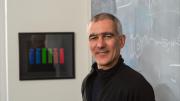The Royal Swedish Academy of Sciences today conferred the Nobel Prize in Chemistry on Moungi G. Bawendi, Louis E. Brus, and Alexei I. Ekimov. The trio were honored for “for the discovery and synthesis of quantum dots,” crystals so small that they are governed by quantum mechanics. Quantum dots are now used in nanotechnology that improves LED lamps, enhances television displays, and illuminates tumors. Ekimov and Brus were honored for successfully creating quantum dots in the early 1980s, and Bawendi for revolutionizing the manufacturing process in 1993. (Read the Nobel announcement, with links to more scientific information, here.)
Bawendi ’82, A.M. ’83, is the Wolfe professor of chemistry at the Massachusetts Institute of Technology. In 1988, he conducted postdoctoral research with Brus at Bell Labs. Though Brus had successfully created quantum dots, he could not control their size or quality. For commercial use, quantum dots need to be smooth and similarly sized. Five years later, at MIT, Bawendi had a procedural breakthrough. First, he precisely saturated a solvent with substances that form nanocrystals, which caused tiny “crystal embryos” to form simultaneously. Then, by heating the solution to specific temperatures, he could control the size of the quantum dots, and the solvent smoothed the crystals’ edges. As the Nobel news release put it, “The nanocrystals that Bawendi produced were almost perfect, giving rise to distinct quantum effects. Because the production method was easy to use, it was revolutionary—more and more chemists started working with nanotechnology and began to investigate the unique properties of quantum dots.”
Bawendi was born in 1961 in Paris, France, and received his Ph.D. in 1988 from the University of Chicago. Louis Brus is a professor emeritus at Columbia University, and Alexei Emikov is the former chief scientist at Nanocrystals Technology Inc.









